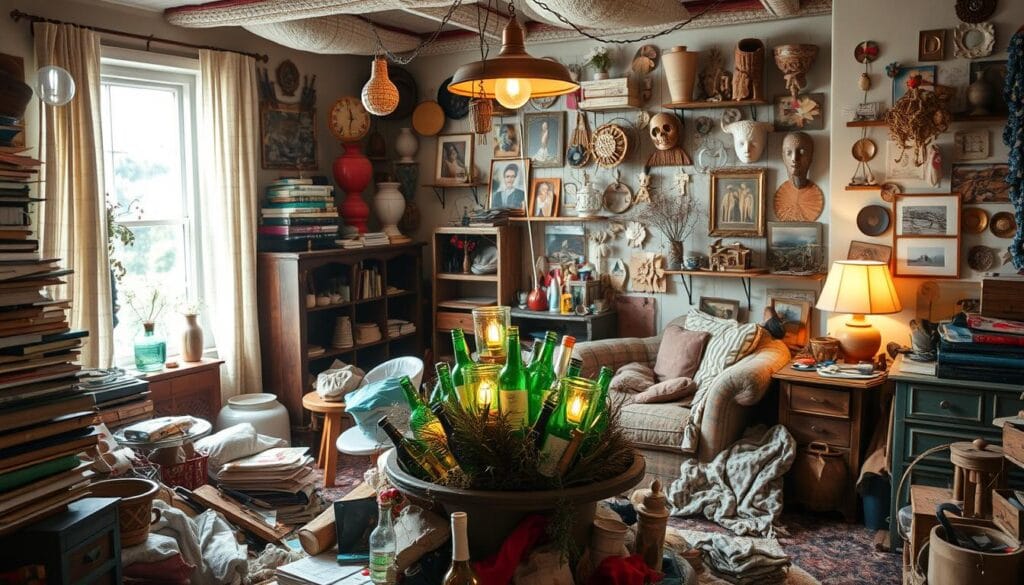Welcome to our cozy spot, where old items get a second shot at life. We love giving new beginnings to both people and things. Think of that old rocking chair or a vintage denim jacket from a thrift store. These may seem worn out, but with creativity, they can become treasures. Envision turning the denim into a stylish tote or the chair into a cool garden planter. We focus on upcycling and sustainable decor. We’re thrilled to have you join us on this transformational journey.
Thrifting is more than snagging a bargain; it’s the excitement of repurposing. With ThredUp, eBay, and Poshmark, sustainable shopping has never been easier. A whopping 54% of Gen Z shoppers prefer eco-friendly options. The resale market might hit $64 billion by 2024. This approach doesn’t just save money—it helps the planet. The average American home throws out 81 pounds of clothes yearly. Upcycling helps decrease this waste.
But what makes us adore upcycling? It’s the thrill of discovering unique finds, the happiness in making the old new again, and the pride in supporting sustainability. About 70% of people are okay with spending more on green products. This shows a trend towards eco-conscious shopping. Thrift shoppers, making up 83%, love the uniqueness of their finds. They say it makes shopping exciting.
So, let’s grab our tools and get ready for some fun DIY projects. Together, we can transform overlooked items into stunning home additions. Let’s give old things new life!
Key Takeaways
- Upcycling breathes new life into old, forgotten items.
- Platforms like ThredUp, eBay, and Poshmark make thrifting accessible to everyone.
- 54% of Gen Z consumers prefer sustainable shopping practices.
- The resale market is predicted to reach $64 billion by 2024.
- 71% of consumers are willing to pay more for sustainable products.
Understanding Upcycling: A Fresh Perspective
In our busy world, it’s common to throw away old things without thinking twice. Yet, upcycling provides a green way to tackle this issue.
What is Upcycling?
Upcycling means creatively reusing waste to make new, better products. It turns trash into treasures, making old items useful and beautiful again. By upcycling, we get creative, help the planet, and keep stuff out of dumps.
Learn more about upcycling initiatives.
The Environmental Benefits
Upcycling does more than just make cool stuff. It cuts down on our carbon footprint, reduces waste, and saves natural resources. Upcycling means less trash in landfills and uses less energy and water than making new items.
Economic Advantages of Upcycling
Upcycling also has economic perks. It can turn a hobby into a profitable business. The upcycling market was worth $10 billion in 2021 and is growing. Small businesses make unique items that sell for more. Plus, using less waste saves money for both makers and buyers.
| Aspect | Traditional Recycling | Upcycling |
|---|---|---|
| Energy Consumption | High (e.g., 95% less energy than producing new aluminum from raw materials) | Lower (Minimal processing required) |
| Waste Reduction | Moderate | Significant (Up to 30% reduction) |
| Economic Value | Standard | Higher (20-50% more valuable) |
| Product Quality | Prone to downcycling (lesser quality) | Enhanced quality |
Upcycling helps us find value in what we used to see as trash. It beautifies our homes, benefits the economy, and is good for the planet.
Inspiring Upcycling Success Stories
We’ve witnessed amazing DIY upcycling transformations. These projects not only give old items a new life but also inspire a fresh view on waste. By looking into these success stories, we see the strength in repurposing and how it sparks creativity.
Home Décor Transformations
You might have heard stories about outdated furniture turning new again. Imagine a vintage stool revived with fabric and $10. Or a once pricey brown couch, made chic by designer Cindy Blanco. These upcycling ideas save money and lessen our carbon footprint.
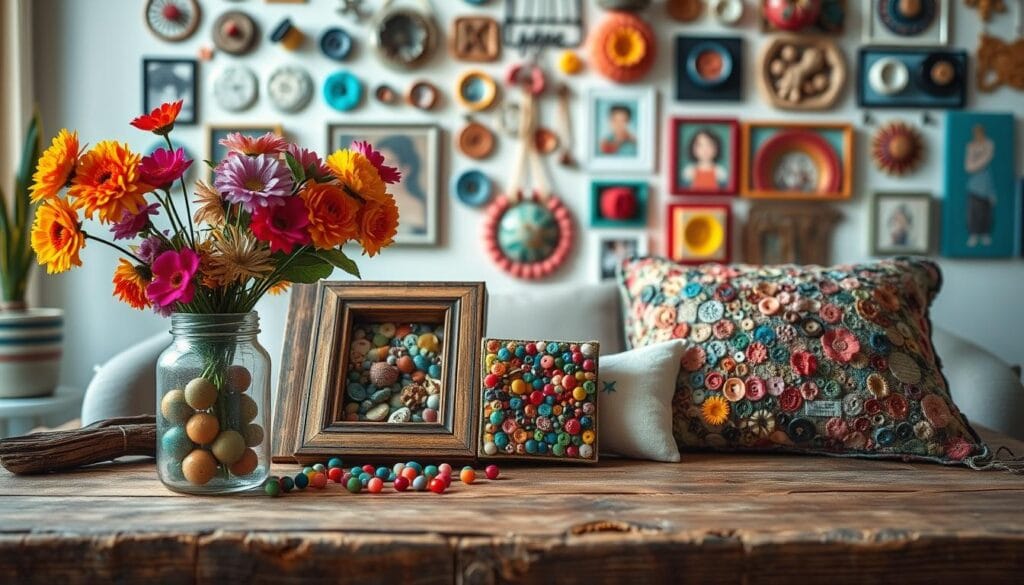
Fashion and Clothing Revivals
Upcycling brings a new life to fashion, following the reduce, reuse, recycle idea. Think about turning old jeans into something trendy. Fashion lovers are now using old textiles for something unique. This reduces water use by 80% compared to making new clothes. It makes being eco-friendly stylish.
Creative Gifts Made from Old Items
Gifting upcycled items has a special charm. Consider jewelry from old silverware or frames from reclaimed wood. Surveys show 60% of people find such gifts more meaningful. They’re creative, sustainable, and personal.
Upcycling does more than just change items; it helps the planet and communities. It reduces trash in landfills, creates jobs, and cuts carbon emissions. With each upcycled project, we step towards a sustainable, inventive future.
| Aspect | Impact |
|---|---|
| Waste Reduction | 80% of discarded items can be repurposed |
| Consumer Savings | DIY projects save 30-50% compared to new items |
| Market Growth | USD 400 billion by 2025 |
| Job Creation | 1.5 million jobs worldwide |
| Environmental Impact | 30% reduction in carbon emissions |
How to Get Started with Upcycling
Diving into upcycling opens your eyes to many creative options. It also helps us keep our planet healthy. By using simple materials, you can give old items a new purpose. Are you ready for this eco-friendly journey? Let’s prepare and get inspired!
Tools and Materials You Need
Starting with the right tools is crucial in upcycling. Here’s what you’ll need to begin:
- Scissors
- Glue
- Paint
- Sewing machine
- Sanders
- Protective outdoor paints
Quality materials, like good paint brushes, make a big difference. Avoid cheap brushes; they could ruin your work with poor coverage and stray bristles.
Selecting Items for Upcycling
Choosing the right items is essential for a successful upcycling project. Look for pieces that inspire you, whether they’re from a thrift store or your attic. Here are some popular upcycling materials:
- Wooden furniture
- Old clothes
- Glass jars
Take on the challenge and watch your creativity soar with every unique piece! Remember, each upcycled item tells a special story of change.
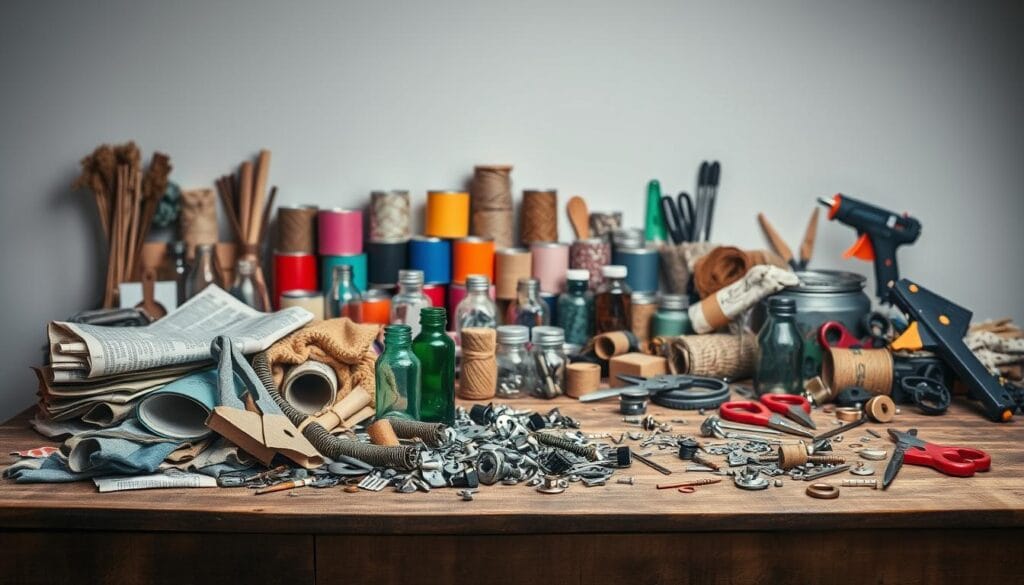
Setting Up Your Workspace
Having a special area for your eco-friendly crafts is important. A neat space helps keep your ideas flowing and projects on track. Here’s how to create the best setup:
- Ensure you have ample space to work comfortably.
- Keep your tools and materials organized and easily accessible.
- Invest in good lighting; natural light is best if possible.
- Set up a clean and safe work environment, especially if you’re using chemicals or tools.
This preparation not only makes projects easier but also boosts your creativity. And always remember to enjoy the process!
Upcycling Techniques to Explore
Discovering upcycling can change both your home and the planet! Every year, tons of trash pile up in landfills. Yet, by turning old furniture or clothes into something new, we can cut down on waste. Let’s look into some creative ways you can start your next upcycling project.
Furniture Restoration Ideas
Upcycling old furniture can give it a fresh start. It doesn’t matter if it’s a scratched coffee table or a worn chair. You can make them look new again. Using simple techniques like painting or adding new knobs can make a big difference. By choosing to restyle instead of buy, we save energy and resources.
Fabric and Textile Projects
Did you know 92 million tons of clothes are thrown away yearly? By upcycling textiles, we fight this waste problem. Projects like thrift flipping and adding patches can breathe new life into old garments. Some brands use leftover fabrics to make new clothes, helping our planet. This way, old clothes get a second chance, making your style unique and eco-friendly.
Repurposing Glass and Plastic
Too often, glass and plastic items end up as pollution. But, these materials are great for creative projects. Glass jars can be turned into beautiful vases, while plastic bottles can become decorative planters. These projects help materials last longer and cut down on waste.
Here’s a look at the benefits of different upcycling methods:
| Technique | Environmental Impact | Creative Potential |
|---|---|---|
| Furniture Upcycling | Minimizes raw material use and manufacturing energy | High – Customizable designs and finishes |
| Textile Upcycling | Reduces textile waste; lowers clothing production needs | High – Numerous methods like patchwork, embroidery |
| Repurposing Glass and Plastic | Prevents landfill waste, repurposes existing materials | Medium – Versatile applications for décor and storage |
Adding upcycling into our lives does more than just change our homes. It sparks creativity and supports a healthier planet! Let’s all try to be more sustainable. 🌱
The Role of Social Media in Upcycling
Social media is a key player in boosting upcycling ideas today. It offers a vast array of tips and how-tos, making upcycling easier and fun. It’s exciting to see how we use this tool to spark creativity and grow a strong upcycling network.
Finding Inspiration on Platforms
Instagram and Pinterest are full of ideas for eco-friendly home decor. They showcase projects that turn waste into wonderful and useful items. A quick look for “upcycled furniture” can uncover ways to redo old chairs, use wooden pallets differently, or make decorative items from unused glass bottles. The vivid images on these sites help us see the beauty in things we might throw away.
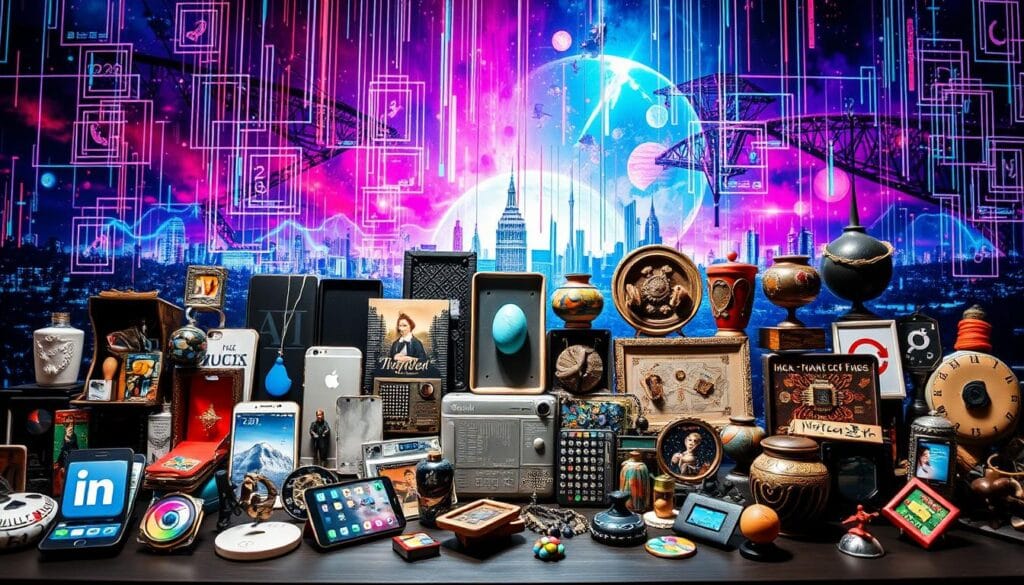
By using these sites, we keep up with new upcycling trends and methods. Recent data shows a 40% increase in DIY upcycling projects on social media. This highlights a rising interest in living sustainably. It’s a great way to learn and develop a love for reducing waste and choosing eco-friendly decor.
Creating a Community Around Upcycling
More than inspiration, social media is a place to connect with an upcycling community. You can follow accounts or join groups where people share your interest in eco-friendly living. This community is a great source for advice, showing off your work, and getting helpful critiques.
Look at Zero Waste Daniel and other groups. They’ve used social media to spread their eco-friendly messages with engaging how-tos. Their work shows how we can all make a big difference through upcycling. Brackish and Sage Silver Jewelry also use these platforms to share their detailed crafting work. It shows how valuable upcycled items can be.
| Brand | Impact | Social Media Engagement |
|---|---|---|
| Zero Waste Daniel | Saved tons of scrap material from landfills | Interactive tutorials and daily inspiration |
| Brackish | Takes 4-5 hours and involves 8 people per piece | Behind-the-scenes crafting processes |
| Sage Silver Jewelry | Weekly restocks based on new creations | Weekly new product reveals |
Being active in these groups boosts your inspiration and involvement in eco-friendly conversations. Sharing your experiences and learning from others helps promote upcycling. It emphasizes the need for a circular economy.
Social media combines inspiration with community, enhancing our upcycling work. It also deepens our dedication to sustainable living.
Teaching Kids About Upcycling
Teaching kids about upcycling is great. It teaches them valuable lessons while having fun. They learn through enjoyable and educational activities.
Fun Projects for Children
Working on DIY projects with kids is an exciting journey. Think about turning old magazines into colorful collages. Or making crafts from used plastic bottles. We can guide our children to see potential where others see waste. We teach them to value creativity and innovative thinking.
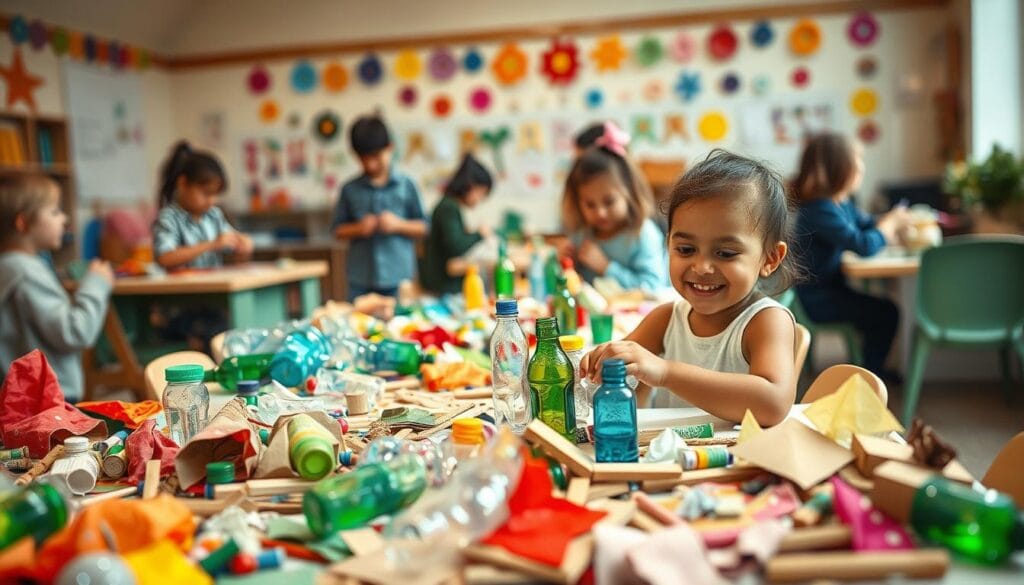
Benefits of Upcycling for Kids
Upcycling offers many benefits for kids. Children who do hands-on activities like upcycling become 25% better at solving problems. They also feel 40% more confident after making something new. These projects help them grow in important ways, not just keep them busy.
Encouraging Creativity and Sustainability
Upcycling is perfect for boosting creativity and sustainability. Starting these projects brings excitement and curiosity. At community swaps, the variety of materials for crafts increases by 50%. This encourages sharing and boosts children’s environmental awareness by 60%.
Families doing upcycling projects together spend 35% more quality time. This strengthens family bonds and enhances the activities’ emotional and creative benefits.
Here’s a look at some major upcycling advantages for kids:
| Aspect | Benefit |
|---|---|
| Problem-Solving Skills | 25% increase |
| Self-Esteem | 40% improvement |
| Environmental Awareness | 60% enhancement |
| Family Bonding | 35% increase |
The impact of upcycling goes beyond making crafts. It prepares our children for a sustainable, creative future.
Upcycling in Your Community
Community upcycling projects are more than just making beautiful things. They help bring us together and make our neighborhoods sustainable. Every day, we create almost 5 pounds of trash. By reducing this, we can help our environment a lot.
Local Upcycling Initiatives
We start upcycling in our community by creating centers. At these places, people can share tools, materials, and ideas. This helps reduce the amount of waste going to landfills.
Turning trash into treasure also cuts our carbon footprint. The global upcycling market might hit $410 billion by 2027. This shows more people care about being sustainable.
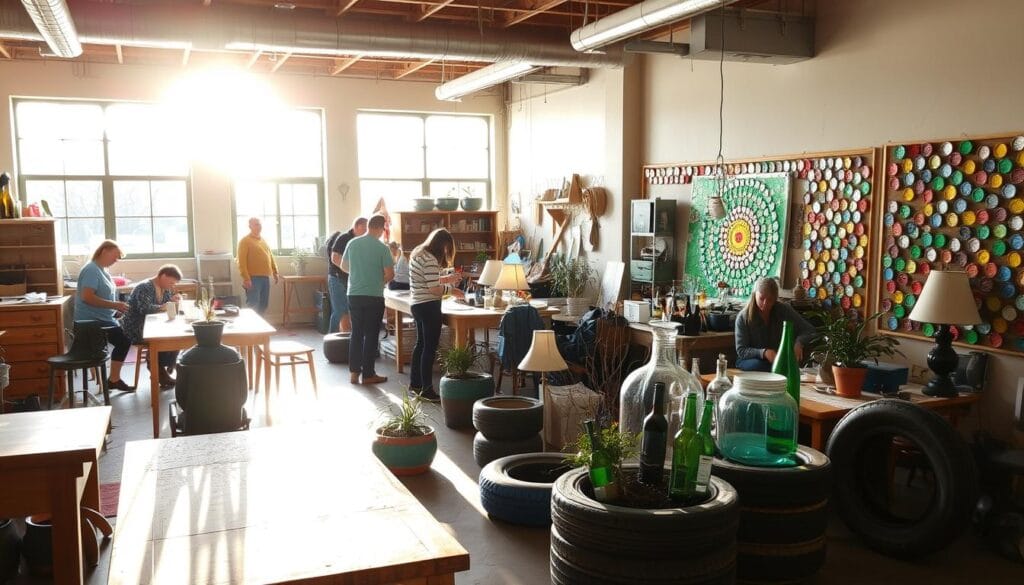
Organizing Upcycling Workshops
Upcycling workshops are great for spreading knowledge and bringing people together. They teach us how to give old items new life. This strengthens our community bonds.
The home décor market is embracing upcycling. It could represent 40% of the market by 2025. Now is the perfect time to start learning and sharing.
Collaborating with Local Artists
Working with local artists on upcycling can lead to innovative and fun projects. Artists add creativity and a unique flair to workshops. This makes learning enjoyable.
Together, we create upcycled items that are both useful and pretty. This showcases the artistic side of sustainability.
We should all decide to reduce, reuse, and reinvent through these fun community activities. As interest and market opportunities grow, every small step helps create a sustainable future.
The Future of Upcycling
The future of upcycling looks very promising, with new trends, supportive policies, and businesses jumping onboard. It’s more than a trend. It’s a key part of becoming more sustainable. Here, we’ll explore what’s driving this movement, including trends, how businesses are getting involved, and the important policies that help.
Trends Shaping the Upcycling Movement
A major trend is the move toward zero waste and circular economies. Companies like Patagonia and Levi’s lead the way, showing us how old clothes can become new again. They use textile recycling to cut down on the need for new materials. Another big trend is composting clothes made from 100% natural fibers, which leaves no waste behind. These innovative steps are shaping a greener future.
How Businesses Are Embracing Upcycling
More companies see upcycling as essential to their green plans. Brands like H&M and Eileen Fisher have programs to take back and recycle clothes. This helps create a circular system. Also, efforts by Patagonia and Allbirds to reduce environmental impacts show their dedication. These actions meet a growing demand from customers who want products that are good for the planet.
Policy Changes and Support for Upcycling
Policies that support upcycling are key to moving it forward. Around the world, governments offer grants and tax breaks to encourage sustainable actions. They’re also making rules to fit upcycling into waste management systems. This makes it easier for companies and people to adopt sustainable practices. Policies that push for zero waste and backing for green businesses are important for making upcycling more common.
With new policies, business strategies, and strong trends, upcycling is changing how we view waste. By turning waste into valuable resources, we’re building a culture of sustainability and creativity. Looking ahead, upcycling will be a normal way to create a greener future.
Challenges of Upcycling
Upcycling is a rewarding journey that comes with challenges. These range from finding good materials to managing time well. Understanding these hurdles and how to jump over them is key. Let’s explore the common challenges and how to tackle them.
Overcoming Common Obstacles
Finding the right materials is a big challenge in upcycling. It’s hard to find items that are durable and look good. But by sharing resources and using thrift stores and online markets, we can find great materials. This helps turn ordinary items into amazing pieces.
Dealing with Time Constraints
Time management is tough for many upcyclers. Making time for projects alongside daily tasks requires good planning. Breaking projects into smaller tasks helps make things less daunting and boosts creativity. For example, getting materials on the weekend and assembling during some evenings can make things smoother.
Finding Quality Resources
Finding good upcycling resources takes patience and effort. Thrift flipping is a good start. It’s about repurposing thrift store finds, which also supports sustainable living. Also, connecting with local artists and joining upcycling workshops can spark new ideas. This can lead to discovering unique items and creative insights.
To improve your upcycling projects, check out creative ways to upcycle furniture. It offers tactics to save time and boost project quality. By tackling these upcycling challenges, we can turn the impossible into beautifully upcycled masterpieces.
Sustainable Materials for Upcycling
Upcycling is about picking materials that look great and help our planet. Materials like bamboo, reclaimed wood, and recycled fabrics are good for this. They are better for the environment and make our projects special.
Eco-Friendly Options to Consider
Sustainable upcycling materials are really important. Bamboo grows quickly and doesn’t need much pesticide. Reclaimed wood makes durable, beautiful furniture without cutting down more trees. Recycled fabrics, like old clothes, help cut down on waste. They keep 92 million tons of clothing from getting thrown out each year.
Where to Source Materials
Finding materials for upcycling can be fun. Check out thrift stores, yard sales, and local online marketplaces. You can find great used items that need a new purpose. Community exchanges and local upcycling places also offer unique materials, often for free or very cheap.
The Importance of Local Sourcing
Buying from local upcycling stores is good for the environment and the community. It supports local businesses and reduces our carbon footprint. Plus, it ensures we have a steady supply of cool materials. This choice helps us be creative and sustainable at the same time.
Using sustainable upcycling materials and getting them locally changes our homes and how we think about waste. It’s a great way to turn discarded items into something beautiful and valuable.
Celebrating Your Upcycled Creations
Showing off your upcycled projects brings a unique joy. You can do this through local shows, online, or by inviting friends over. It’s a great way to share your creativity with others.
Showcasing Your Projects
Local art shows and craft fairs are great places to present your work. They let you connect with the community. You show how you turn old materials into something new and beautiful.
Online sites like Pinterest and Instagram also let you reach more people. They’re perfect for inspiring others with your projects. Sharing your creations in these ways feels very rewarding.
Documenting Your Journey
Sharing your DIY projects on blogs or social media is inspiring. It helps you keep a record of what you’ve learned. This is great for others just starting and for tracking your own progress.
Hosting Upcycling Parties
Upcycling parties are a fantastic way to get friends and family involved. These events foster collaboration and promote recycling. They’re fun and make a positive impact by spreading the word about upcycling.
| Benefit | Impact |
|---|---|
| Showcasing Upcycling | Connects with community, inspires others |
| Documenting DIY Projects | Shared insights, personal growth tracking |
| Upcycling Parties | Engages community, promotes sustainable practices |
Conclusion: Embracing the Beauty of Second Chances
As we wrap up our journey with upcycling, let’s think about its big impact. It’s more than changing items—it’s about changing how we see using things and throwing them away. Choosing upcycling means aiming for a future where being creative and responsible come together.
A Call to Action for Everyone
We call on everyone, from single people to big companies, to try upcycling. This choice helps cut down on waste and supports a green lifestyle. Imagine if we all started doing this. Upcycling makes the simple things shine, showing the hidden value in what’s around us.
The Long-Term Impact of Upcycling
The benefits of upcycling go a long way. It lessens harm to our environment, boosts creativity, and teaches us to use what we have wisely. Upcycling helps us develop practices that are good for the earth and make our lives richer. Each upcycled piece shows cleverness and care for our planet.
Building a Sustainable Future Together
Upcycling together makes our communities stronger, more creative, and environmentally friendly. Making wise choices now leads to a bright and lasting future. Let’s keep finding new life for old things and celebrate second chances. By doing this together, we can make a future that is better and greener. 😊


